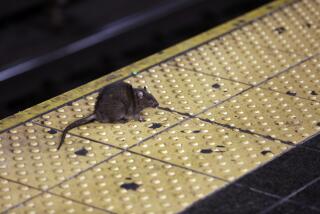U.S. Marks 500th Rodent Study, but Activists See 500 Outrages
- Share via
WASHINGTON — For the federal government, it was a landmark.
The U.S. National Toxicology Program, which determines what chemicals may be hazardous to your health, recently hailed the completion of its 500th two-year study with rats and mice as test subjects.
The 500th report is on naphthalene, the principal ingredient in mothballs, and it shows that the chemical causes cancer--in rats, anyway--leaving scientists and regulators to wrestle with the question of whether it also poses a risk to humans.
And this, to be sure, is the reason why the toxicology program--part of the National Institute of Environmental Health Sciences--is taking this so seriously, and noting it as a landmark.
It is the latest in a series of studies “that has influenced what is allowed in your drugs, your water, your foods, your air,” and what often has served as the formation of regulatory action by the Food and Drug Administration, the Environmental Protection Agency, the Occupational Safety and Health Administration and the Consumer Product Safety Commission.
“We are proud. . . . These 500 tests have had a profound effect on our health and the length of our lives,” says Kenneth Olden, director of the program. “In 1997 and 1998 alone, nine of these studies were the basis for regulatory decisions . . . . “
Not everyone is so appreciative, however.
Animal rights activists--predictably unhappy at the use of animals as test subjects--were incensed that the government would make a big deal out of the growing number of completed studies.
“Five hundred studies where rats are poisoned and killed is nothing to celebrate,” says Lisa Lange, of People for the Ethical Treatment of Animals. “Rats are smart, friendly, curious and sweet, and make wonderful companion animals--and they have zero protection under federal laws. And the federal government should be ashamed of this.”
The government is anything but ashamed.
It lists numerous cancer-causing ingredients or chemicals that have been regulated or dropped from use as a result of its work with rats:
* Tetrachloroethylene and carbon tetrachloride--removed from home cleaning fluids;
* Mirex--restricted as a pesticide and fire retardant;
* Benzene--the toxicity of which led to collars around gasoline pump nozzles that reduce fumes while people fill up their tanks;
* Phenolphthalein, once the active ingredient in most over-the-counter laxatives--removed from the market;
* Dichlorvos--flea collars and pest strips using this insecticide were removed from the market; and
* Various food dyes have been regulated by the FDA or dropped by manufacturers.
The agency defends its use of rodents, saying they are inexpensive to breed and keep but are biologically similar to humans--and because “their long use in laboratories has taught researchers a great deal about them.”
Moreover, using rats and mice allows the studies to identify responses that are the same in both species.
“If something causes tumors in both species, and especially in both genders of each, it is probably very active in causing tumors,” the agency says. And “if the chemical causes tumors that are rare--and that is rarely occurring in non-exposed animals--that raises additional concern.”
Any scientist, organization or even a member of the public can nominate a chemical for study. These are selected based either on existing evidence or suspicion that they are cancer-causing--or simply because large numbers of people are exposed to them.
They are often subjected to one or more short-term tests before being picked for the most in-depth and costlier two-year studies.
Typically, if a chemical causes cancer in rodents, it usually--with only rare exceptions--will cause cancer in humans too.
However, “unlike the old cliche that ‘everything causes cancer,’ almost half of the chemicals tested do not produce tumors in laboratory rodents,” the agency says.






